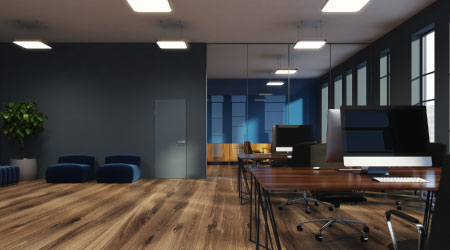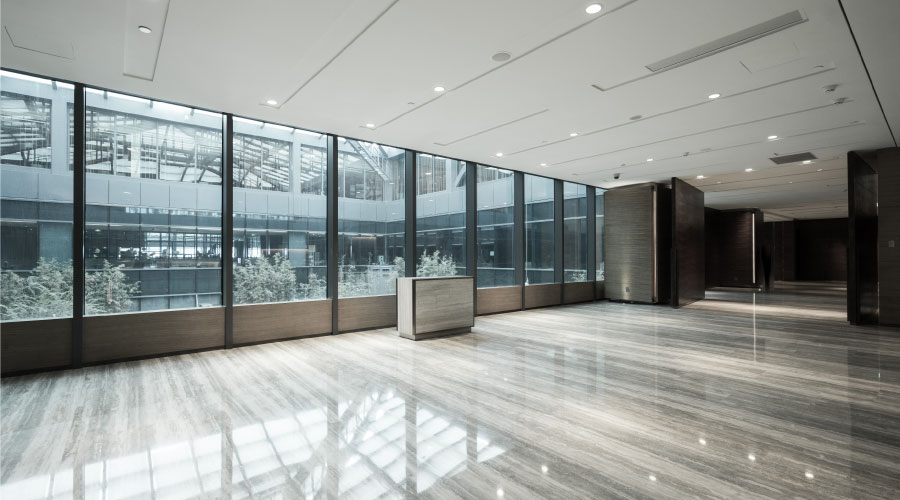Expanding Alternatives for Resilient Flooring
Hard-surface options help managers address needs in public areas, patient rooms, hallways, and offices
By Christopher Capobianco
The decision to install new resilient flooring is among the toughest issues facing managers in institutional and commercial facilities. The complicating factors include the fact that some of the most challenging areas of these facilities — including public areas, patient rooms, offices, and hallways — traditionally have been reserved for hard-surface materials instead of carpet.
Resilient flooring has been a popular choice for decades. Among the familiar products are vinyl composition tile (VCT), but managers might not be as familiar with some product options, including solid vinyl tile, rubber flooring, linoleum and cork.
To match a facility’s flooring needs with the most appropriate product options, managers need to understand more about the composition of popular flooring options, as well as their maintenance requirements.
Vinyl composition, tried and true
Because VCT and its predecessors, vinyl asbestos tile and asphalt tile, have been around for so long, managers tend to make product decisions on a new floor based on familiarity. VCT is still about the least expensive floor to install, and it wears well in a variety of traffic areas. Its downsides include a lack of design options — plain, marbleized, 12-inch squares only — and the high cost of maintenance, due to its porous nature.
An alternative to conventional resilient flooring is site-applied, water-based polyurethane finishes, which are increasingly popular. One coat can provide a high gloss for a long time without finishes or buffing, offsetting its high up-front cost. Polyurethane is appropriate for a variety of resilient floors, including concrete, stone and terrazzo.
With more options for resilient flooring, managers are moving away from VCT for reasons that include design variety, green materials and less maintenance. Solid vinyl tile, rubber flooring, linoleum and cork now are becoming increasingly popular in commercial spaces. These products usually cost more up front than VCT, but they can offer better looks, more environmental benefits and, often, lower maintenance requirements.
One of the first step-up products from VCT is VCT with higher vinyl content that is marketed as high-performance vinyl or vinyl-enhanced tile. These products have some variations on the marbleized visual and often are available in larger sizes, including 18 inches square. They also sometimes have the appearance of real granite, natural linoleum, terrazzo or other designs.
These products sometimes can require a low-maintenance program, meaning mopping, autoscrubbing and dry buffing without the use of floor finishes — unless the owner wants high gloss, in which case managers can specify a conventional maintenance program, meaning floor finishes, sealers or burnishing.
Solid vinyl tiles
Solid vinyl tile (SVT) is becoming an increasingly popular design option. Often incorrectly called luxury vinyl, these products are appropriate for a variety of spaces, especially in health care and retail facilities.
Described in ASTM F1700, Standard Specification for Solid Vinyl Floor Tile, the most popular products in this category are layered products with a clear vinyl wear layer that accurately imitates a variety of natural materials, including wood planks, stone, slate, tile, glass and several other visuals printed on photographic print film. Some designs are so realistic it is hard to tell the difference.
From a maintenance perspective, the clear vinyl wear layer makes the product fairly stain resistant and easier to clean, but on smoother designs it might show a great deal of scuffing. Many of these products do well in moderate traffic with a low-maintenance program and can perform with conventional maintenance for a high gloss.
Because of the non-porous nature of some clear vinyl wear layer products, floor-finish adhesion can be an issue, so managers should use the product in a test area. It might be necessary to apply a seal coat on a new floor to aid in floor-finish adhesion.
A number of products coming on the market have the appearance of SVT products. In reality, they are non-vinyl or non-PVC floors that only look like vinyl. These products generally do not accept floor finish well, so it is critical to get instructions from the manufacturer.
Rubber bounces back
Rubber flooring is making a comeback because of its acoustic properties, slip resistance and lower maintenance costs. This flooring is not just the familiar coin-top, raised circular design. Traditional, marbleized smooth rubber has been making a comeback recently in more updated colors.
This product has been around for 60 years or more and is historically one of the toughest, most durable flooring options for high-traffic areas. Recycled rubber flooring and rubber/cork tile also fall into this category, especially for green building projects.
Rubber often is appealing because of its inherent slip-resistant qualities, but someone has the idea to shine a rubber floor using floor finish. If slip resistance is a high priority, the floor will do better without a finish.
That is not to say a floor finish is slippery in any way. Rubber is more slip resistant without a finish than with one, so managers might prefer to use a low-maintenance program on it. This is especially true because some good one-step products contain detergents, waxes and polymers to clean rubber well and leave behind a film for a slight gloss.
Managers should note that textured rubber floors, such as the circular designs or stipple finish, might require a brush, not a pad on the machine, to periodically deep clean the surface.
Linoleum returns
Linoleum has made a comeback since the early 1990s. The word linoleum does not mean sheet vinyl, which often is called linoleum incorrectly.
What’s the difference? Real, natural linoleum is made from natural ingredients, including linseed oil, pine rosin, ground cork, wood flour, and a jute backing. Linoleum does not contain vinyl.
Linoleum is a common choice for hard-surface flooring in green designs because it is a natural product and can help a project qualify for points under the Leadership in Energy and Environmental Design (LEED) rating system. Linoleum tile and sheet flooring are tough and durable products that managers can used in almost any traffic area.
Maintaining linoleum is different than maintaining vinyl. For example, some manufacturers apply a coating to linoleum products during production, while others do not. So cleaning crews need to follow manufacturer guidelines.
It also is important to stay away from high-pH strippers and cleaners because frequent use can damage a linoleum floor. Linoleum maintenance is not difficult. It’s just different, and when done correctly, it makes for a beautiful floor.
One common thread for all of these products is the need to follow the flooring manufacturer’s cleaning guidelines and understand the need for gloss level before implementing a floor-maintenance program.
Counting on cork
Finally, cork is another resilient flooring option that is becoming more popular because of its green benefits, softness, sound and heat-insulating characteristics, and unique look. Although classified as resilient flooring, cork floors have many of the same characteristics as wood flooring with regard to handling, installation and finishing.
Managers are most commonly specifying several cork flooring products.
A cork floor features a vinyl backing and a vinyl wear layer, which is maintained more like a vinyl floor.
Traditional, natural-cork tile and cork floating floors are handled and maintained like wood. Contractors sometimes install unfinished cork and stain or finish it on site. But most cork floors receive a factory finish of urethane, acrylic or wax. Urethane and acrylic finishes are maintained similar to wood: Damp mop with not too much water.
Waxed cork needs a great deal of work to maintain, and few housekeeping crews know how to use real paste wax.
Regardless of the finish used on these floors, cleaning crews must follow the manufacturer’s maintenance guidelines. They should avoid applying standard, liquid floor finishes on cork because floors require occasional stripping, but the chemicals involved could damage the cork.
A screen-and-recoat procedure similar to that used on a wood floor is more advisable because it will prevent the factory coating from wearing off. If the factory coating does wear off, homogeneous cork has color all the way through, so crews can sand and refinish it similar to wood floors.
Veneer-cork products have a thin layer that provides their unique visuals, but cleaning crews cannot sand them. So if the factory coating on a veneer wears off, the floor is ruined. Homogeneous cork floor tiles are the more durable option for managers who have a choice when selecting cork for high-traffic areas.
Training for success
To stay up to date on the newest types of flooring products on the market, managers can provide training for housekeeping crews to review new procedures and practices.
One training source is the Institute of Inspection, Cleaning and Restoration Certification, which is increasing its training programs and certification offerings for hard-surface maintenance to help meet the demand for more specialized training.
Many manufacturers of these products also offer training in product specification, installation and maintenance.
Christopher Capobianco is the president of Christopher Collaborative Inc., a company that includes Flooring Answers — www.FlooringAnswers.com — which provides technical support, training, testing and inspection services. He also serves as chairman of the Flooring Covering Installation Contractors Association ASTM Committee F.06 on Resilient Flooring, and the Institute of Inspection, Cleaning and Restoration Certification.
Related Topics:











